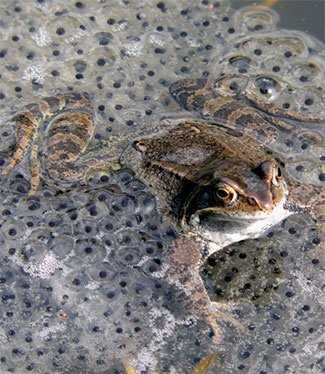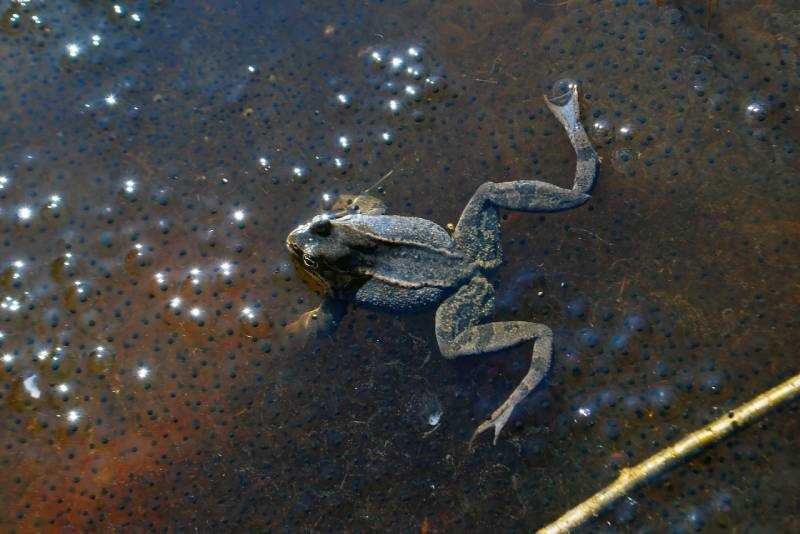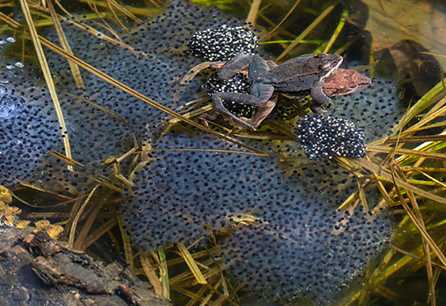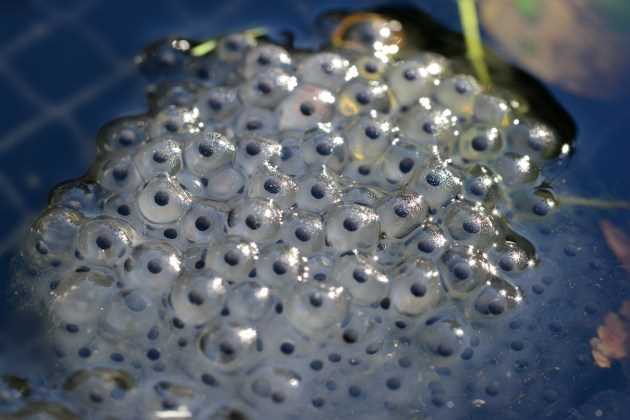Frogs are fascinating creatures that have been around for millions of years. One of the most intriguing aspects of their life cycle is where they choose to lay their eggs. These small, slimy creatures navigate their way to various habitats to ensure the survival of their offspring.
So, where do frogs lay their eggs? These clever amphibians carefully select their laying spots to provide the best chances for their eggs to develop and thrive. Some frog species prefer quiet, stagnant bodies of water such as ponds or small lakes. The stillness of the water helps to protect the eggs from being swept away by strong currents or disturbed by predators.
On the other hand, there are species of frogs that prefer to lay their eggs in running water. These energetic creatures choose fast-flowing streams or rivers, where the constant movement helps to aerate the eggs and prevent them from suffocating. The rushing water also provides a constant source of food, ensuring that the developing tadpoles will have plenty to eat.
Interestingly, certain types of frogs have even adapted to lay their eggs in more unusual spots. Some tree frogs, for example, lay their eggs on leaves that hang over water. This clever strategy allows the tadpoles to drop into the water when they hatch. Other frogs may lay their eggs in moist soil near a water source, knowing that the rain will eventually fill the area and provide a safe environment for the eggs to hatch.
The Life Cycle of Frogs: From Eggs to Adults
When frogs lay their eggs, they do so in bodies of water, such as ponds, lakes, or even temporary pools. The female frog lays a large number of gelatinous eggs, which are typically attached to aquatic vegetation or other substrates.
Once the eggs are laid, the adult frogs leave them to develop on their own. The eggs are vulnerable to various environmental factors and potential predators during this stage. However, the gelatinous coating provides some protection by deterring some predators and preventing the eggs from drying out.
Over time, the eggs undergo a process called embryonic development. The embryos start as tiny black dots within the gelatinous mass and gradually grow into tadpoles. This growth is fueled by the nutrients stored within the eggs.
Once the metamorphosis is complete, the tadpoles have fully transformed into adult frogs. At this point, they have the ability to leave the water and navigate both terrestrial and aquatic environments. They will then continue their life cycle by reproducing and laying eggs of their own.
Environmental Factors that Influence Frog Egg Laying
Frogs, like many other amphibians, lay their eggs in water. However, they do not lay their eggs just anywhere. Various environmental factors play a significant role in determining where these frogs choose to lay their eggs.
Water Quality
One of the most crucial factors influencing frog egg laying is water quality. Frogs prefer clean, unpolluted water bodies for their eggs to thrive. High levels of toxins, pollutants, or other contaminants can be detrimental to the eggs and can significantly reduce their chances of survival. Therefore, frogs tend to lay their eggs in water bodies with good water quality, such as lakes, ponds, or slow-moving streams.
Vegetation
Frogs often lay their eggs near or among vegetation. Aquatic plants provide essential cover and protection for the eggs, acting as camouflage and reducing the likelihood of predation. The presence of vegetation also helps to create a suitable environment for the development of frog eggs by providing oxygenation and necessary nutrients.
Temperature
Temperature is another critical factor that influences frog egg laying. Different frog species have specific temperature requirements for their eggs to develop successfully. Frogs typically choose water bodies with temperatures within their preferred range. Warm temperatures can accelerate egg development, while colder temperatures can slow it down. Frogs are highly sensitive to temperature changes and will choose suitable laying spots based on their specific needs.
Shelter and Safety

Frogs prefer to lay their eggs in areas that provide appropriate shelter and safety from potential predators. They may choose locations such as shallow areas with dense vegetation, stagnant ponds, or tucked away corners of water bodies to minimize the risk of predation. These spots offer protection from larger predators, including fish, birds, or other amphibians that may pose a threat to the fragile eggs.
Overall Habitat Suitability
Importance of Identifying Preferred Laying Spots for Frog Eggs
Knowing where frogs lay their eggs can help researchers and conservationists monitor the population size and health of frog species. By identifying and protecting these specific areas, we can ensure that the frogs have a safe and suitable environment to reproduce, as well as provide them with the necessary resources to survive and thrive.
Hydrological Conditions and Frog Egg Distribution
One of the factors that greatly influences where frogs lay their eggs is the hydrological conditions of the surrounding environment. Frogs typically lay their eggs in bodies of water, such as ponds, lakes, or slow-moving streams. These aquatic habitats provide the necessary moisture and nutrients for the development of frog eggs.
Frogs are amphibians, which means they require water for breeding and egg laying. The hydrological conditions of these aquatic habitats play a crucial role in determining where frogs choose to lay their eggs. Factors such as water temperature, depth, and clarity can greatly influence the suitability of a location for egg laying.
| Hydrological Conditions | Effect on Frog Egg Distribution |
|---|---|
| Water Temperature | Frogs prefer to lay their eggs in water that is within a specific temperature range. If the water is too cold or too hot, it can negatively affect the development of the eggs. Therefore, frogs are more likely to lay their eggs in areas where the water temperature is optimal for their survival. |
| Water Depth | The depth of the water can also impact frog egg distribution. Some frog species prefer shallow waters, while others may lay their eggs in deeper areas. The availability of suitable depths for egg laying can influence the distribution of frog eggs within a habitat. |
| Water Clarity | Frogs rely on visual cues to select suitable egg-laying sites. If the water is too turbid or murky, it may be difficult for frogs to find suitable locations for egg laying. Clear water allows frogs to identify and select areas with appropriate vegetation, substrate, and other necessary conditions for egg development. |
Vegetation and Its Role in Frog Egg Laying
Vegetation plays a crucial role in the laying of frog eggs. Frogs prefer to lay their eggs in areas with ample vegetation, such as ponds, lakes, or wetlands. The presence of vegetation provides several benefits for the successful development and survival of frog eggs.
Firstly, vegetation offers protection and shelter for frog eggs. The plants provide a physical barrier that shields the eggs from predators, such as fish or birds, that may prey on them. The dense vegetation also helps to conceal the eggs, making them less visible to potential predators.
In addition to protection, vegetation provides an important source of food for tadpoles, the larval stage of frogs. Tadpoles primarily feed on algae and other organic matter found in vegetation. The presence of vegetation ensures an adequate food supply for tadpoles, allowing them to grow and develop properly.
Furthermore, the presence of vegetation can help maintain appropriate water conditions for frog egg development. Aquatic plants help reduce water temperature fluctuations, provide oxygen through photosynthesis, and help filter and purify the water. These factors are crucial for the survival and development of frog eggs and tadpoles.
Frogs also rely on vegetation for mate selection. The presence of certain types of vegetation may attract specific frog species, indicating suitable mating and egg-laying grounds. Therefore, studying the types of vegetation present in an area can provide valuable insights into the diversity and distribution of frog species.
To identify preferred laying spots for frog eggs, researchers often survey the vegetation composition and structure in different habitats. They assess factors such as plant density, species diversity, and water quality indicators to determine the suitability of an area for frog egg laying.
Temperature and Its Impact on Frog Egg Development

Frogs lay their eggs in water bodies, such as ponds, lakes, or wetlands. The temperature of the water directly influences the development of frog eggs. In general, the optimal temperature range for most frog species to lay and develop their eggs is between 20 to 30 degrees Celsius.
When the water temperature is too cold, the development of frog eggs slows down, and it may take longer for them to hatch. On the other hand, if the water temperature becomes too warm, it can have negative effects on the eggs, leading to abnormal development or even death.
Frog eggs are ectothermic, meaning their body temperature is regulated by the surrounding environment, including the water temperature. The eggs absorb heat from the environment, and this heat influences their metabolic processes and development. Warmer temperatures accelerate the metabolic rate of the eggs, leading to faster development and hatching.
However, extreme temperature fluctuations can be detrimental to frog eggs. Rapid temperature changes can disrupt the delicate balance of the eggs’ development, leading to developmental abnormalities or mortality. Therefore, stable and suitable temperature conditions are crucial for the successful development of frog eggs.
Where Do Frogs Lay Their Eggs?
Frogs are fascinating creatures that have a unique life cycle, starting from eggs and developing into adults. One of the most intriguing aspects of their life cycle is the question of where they lay their eggs.
In addition to water, vegetation also plays an important role in frog egg laying. Frogs often choose areas with dense vegetation, such as floating plants or submerged vegetation. This vegetation provides shelter and protection for the eggs, helping them to avoid predators.
Temperature also plays a crucial role in frog egg development. Frogs prefer to lay their eggs in areas where the temperature is suitable for their development. This can vary depending on the species of frog, but generally, they choose spots where the temperature is neither too hot nor too cold.
To avoid predators, frogs have developed various strategies in selecting the ideal spot for laying their eggs. They often choose areas that are difficult for predators to access, such as deep water or areas with dense vegetation. These spots offer protection and increase the chances of survival for the eggs.
Research techniques have been developed to locate frog egg laying spots. These techniques include visual surveys, acoustic monitoring, and DNA analysis. By using these methods, scientists can identify the specific locations where frogs lay their eggs and study the factors that influence their choice.
Research Techniques for Locating Frog Egg Laying Spots
1. Field Surveys: Researchers conduct field surveys in suitable frog habitats such as wetlands, ponds, and streams to visually search for egg masses. This method involves physically visiting potential sites and observing the presence of frog eggs.
3. Environmental DNA (eDNA) Sampling: This technique involves collecting water samples from potential breeding areas and analyzing them for traces of frog DNA. Through eDNA sampling, researchers can detect the presence of frog species even when they are not visually observable, making it an efficient method for locating egg-laying spots.
4. Aerial Surveys: Aerial surveys, typically conducted using drones or airplanes, provide a broader perspective of the landscape, enabling researchers to identify potential frog breeding sites based on visual observations. This method is particularly useful for large, inaccessible areas.
5. Radio Tracking: Radio tracking involves attaching small transmitters to adult frogs and tracking their movements to determine their breeding and egg-laying locations. This method provides valuable insights into the specific habitats preferred by different frog species.
6. Remote Sensing: Remote sensing techniques, such as satellite imagery and LiDAR (Light Detection and Ranging), can be used to identify water bodies, vegetation patterns, and other landscape features associated with frog breeding. These tools help researchers narrow down potential egg-laying spots.
Conservation Efforts to Protect Frog Egg Laying Areas

Frogs lay their eggs in specific habitats that provide the necessary conditions for their development. These habitats can be sensitive to changes in the environment, making it important to implement conservation efforts to protect frog egg laying areas.
Conservation efforts focused on protecting frog egg laying areas are crucial for maintaining the population and diversity of frog species. This is because the survival and reproductive success of frogs depend on the availability of suitable habitats for egg laying.
Preserving frog egg laying areas often involves the protection of wetlands, marshes, and other aquatic habitats. These habitats provide the necessary moisture and vegetation for successful egg development. Implementing measures to prevent habitat destruction and pollution is essential to maintain the quality of these areas.
Conservation efforts may also include the creation of artificial ponds or wetlands to provide additional egg laying sites for frogs. These man-made habitats can mimic natural conditions and provide alternative options for frogs to lay their eggs.
Education and awareness programs are another important aspect of protecting frog egg laying areas. By promoting the importance of these habitats and the role frogs play in maintaining ecosystem health, conservationists can foster a sense of responsibility and encourage individuals to take action to protect these areas.
How Citizen Science Can Contribute to Discovering Frog Egg Laying Spots

One of the main ways in which citizen science contributes to the discovery of frog egg laying spots is through the monitoring of frog populations. Volunteers observe and document frog behavior during breeding seasons, recording the locations where they see frogs and the presence of eggs. This information is then compiled and analyzed by scientists to determine preferred laying spots.
Citizen science initiatives also involve the collection and analysis of environmental data. Volunteers help monitor hydrological conditions, such as water depth and flow, which can have a significant impact on frog egg distribution. They also analyze vegetation types and densities, as well as temperature fluctuations in potential frog egg laying areas. By collecting this data, citizen scientists are able to identify key environmental factors that influence frog egg laying.
Additionally, citizen science projects focus on predator avoidance strategies in frog egg placement. Volunteers help identify potential predators in frog egg laying areas and record their behavior. This data helps scientists understand the importance of choosing specific areas to lay eggs, such as areas with dense vegetation or areas with low predator presence.
Research techniques for locating frog egg laying spots are also a significant part of citizen science projects. Volunteers learn how to identify frog egg masses, which can vary in size and appearance depending on the species. By learning how to identify these egg masses, citizen scientists are better equipped to locate and document frog egg laying spots in their local areas.
Conservation efforts to protect frog egg laying areas are also an essential aspect of citizen science. Volunteers actively participate in habitat restoration projects, removing invasive species, planting native vegetation, and creating suitable breeding habitats for frogs. By creating and maintaining suitable habitats, citizen scientists directly contribute to the preservation of frog populations and their egg laying areas.

I’m Lena Adams—a product of an unconventional upbringing in the African wilderness. My father, a daring explorer of African wildlife, sparked my fascination with reptiles, a passion that intertwined with the tragic loss of my mother during an expedition, leaving an indelible mark on my life. Driven to understand the creatures that captivated my parents, I embarked on my journey, sharing insights about reptiles, frogs, and lizards on my website. Through my explorations and conservation efforts, I honour my family’s legacy while seeking connections—to the creatures, nature, and the mother whose presence I yearn to understand.
